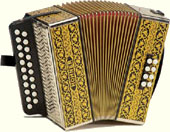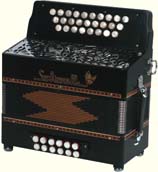
This page is dedicated to Rich Morse, longtime friend and wonderfully creative
founder of the Button Box, who passed far too soon.
See the Tribute Wiki
for stories and pictures from his life.
Melodeon: improving an imperfect world?
The melodeon (or "button box" or just "box") is a small accordion whose keyboard is laid out in rows of buttons. Its small size and loud volume make it great for outdoor situations, and like many people I learned to play it for Morris dancing. Each row is like a harmonica, with the notes of a major scale arranged compactly (without accidentals) so you get different notes pushing and pulling the bellows.
 Most Morris musicians play a 2-row D/G box, meaning you can play
easily in the keys of D and G, uneasily in nearby keys, and not at all in faraway keys like A flat.
Most Morris musicians play a 2-row D/G box, meaning you can play
easily in the keys of D and G, uneasily in nearby keys, and not at all in faraway keys like A flat.
The upside: within the walled garden of a few keys and chords you're a big rich orchestra of sound in a nice light box. The downside: when you venture out of the garden to the wide world of other music, suddenly everything is difficult.
This page is the story of my attempt to expand the garden a little, to develop an expanded D/G layout which preserves the benefits of the original while allowing a wider range of tunes to be played easily. (I'm not the first to try this—see for example the keyboard layouts at melodeon.net.)
If you want to skip the gory details, here's my "improved" layout as a PDF.
Warning: the following is rather arcane if you've never played the melodeon.
The problems
Anybody who plays a D/G melodeon for a while starts to wish for notes and chords that aren't there. You can't play low notes like C and B that show up in a lot of fiddle tunes. You only have D pushing, so if you want an A or E minor chord you're out of luck. Likewise you only have E, C, and C# pulling, so if you want a G or B chord, too bad.
And lots of great tunes use chords you don't have. You can fake B minor and A minor chords but it ain't the real thing. And there's no F chord, or E or F# minor. Finally, there aren't enough accidentals, they're in an awkward place, and sometimes they're in the wrong direction.
We fake our way around these problems (and that's part of the fun), but we yearn for something better. Some people just get a 3-row box, allowing another key and a few more chords at the expense of a heavier box, and without solving many of the above problems. Others customize a 2½-row "Club" model, not quite as heavy as a 3-row. I tried that but was still frustrated because there weren't enough extra notes!

Then I noticed that Saltarelle's Cheviot model used the same frame as a Club, but has a full extra row rather than a half row (achieved by sacrificing one button each from the main rows). More extra notes!
Is it possible with eight extra melody buttons and four extra chord buttons to solve everything? Play fiddle tunes, have all the important notes in both directions, find accidentals in a convenient place, and have all the chords you need for D/G-centric tunes?
My solution
After a few weeks of head scratching and layout scribbling I took a deep breath and ordered a custom Cheviot. Here's the right-hand layout:

On the main rows I added low notes (brown) to cover the fiddle range, sacrificing seldom-used high notes. On the extra (inside) row I added D and F pulling and E and C pushing (blue), placing them as if the inside row were a full C row. As a result, crossing from the G row to the inside row usually feels right because it's the same relation as crossing from the D to G row. And, adding a C# pushing means that now any note of the midrange D and G scales can be played in either direction (and so against any chord).
Then I put accidentals (green) in the remaining spots, making sure all the important notes were present even if located in a funny place. (Accidentals are bound to be in a funny place anyway since they're outside the standard layout "logic".) D# is on push to match the push-only B chord, and G# is on pull to match the pull-only E chord.
(For the top note of the inside row it seemed more useful to restore the high notes C# and E, which had fallen off the top of the main rows, rather than add more high accidentals.)
Chords
Then it was time for the chords. But which ones? It's as if you were marooned on an island eating exactly six kinds of food for years on end, and suddenly someone appeared and said "You can have four more kinds of food! But only four, you have to decide right now, and you can never change your mind!"
Actually I figured out how to have six new chords. Here's the left-hand layout:

On the right are the eight standard D/G bass and chord buttons. For example, ‘G’ is the G bass, ‘G+’ is the G major chord, and ‘Em’ is the E minor chord.
The two bottom left buttons are an F bass and F major chord pulling (to match the F note) and an F# bass and F# minor chord pushing.
The two upper left (purple-ish) buttons add four more chords: B minor, A minor, F# major, and E major. Putting four chords in the place of two works because they can all be played with existing bass buttons. For example, I play A minor with my third finger on the A bass and first finger on the A minor chord. This has turned out to be a great feature—I use B minor and A minor all the time, it didn't take long to get used to the slight extra reach from the bass buttons, and I don't have to move my hand as far as I would if they were a standard bass/chord pair at the far left.
(I only thought of this after ordering the instrument, and it's a non-standard modification so I'm not sure if Saltarelle would have done it for me. But the great guys at The Button Box did!)
Results
So how have all these "improvements" played out in real life? Well, it's a mix. On the plus side I can play a lot of swell tunes I couldn't play before, and have more flexibility on others. Putting the "opposite direction" versions of C, D, and E in their standard C-row locations was a great choice, because when I use them for an alternate fingering it mostly feels sensible rather than unusual. And I love tossing in those new chords, especially B minor, A minor, and F.
On the minus side, while the box isn't quite as heavy as a 3-row, the left hand is still substantially heavier than a 2-row so it's less free and easy to play. And even though I now have all the notes I need, I still sometimes give up on a tune because it's just too convoluted to learn the patterns! On those days I wonder if maybe I should just switch to a piano accordion or a chromatic button accordion??
But most days I still think there's nothing like a button box, hallelujah!

